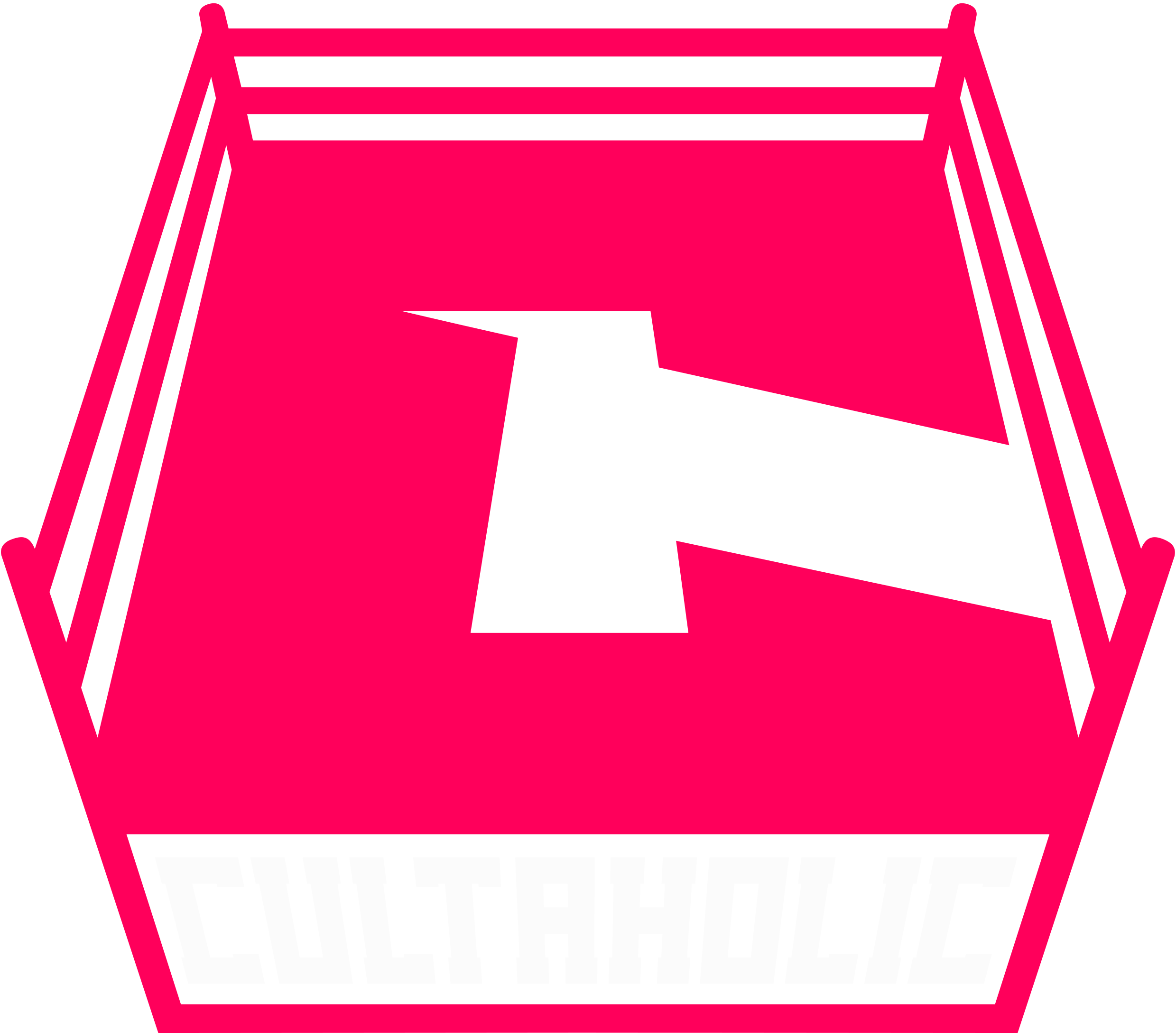10 Things We Learned From WWE Royal Rumble 2003
The one with Brock Lensar & The Undertaker...
If you think today's WWE product is a cesspool of creative bankruptcy and spiteful booking, take a gander at what the company was offering back in 2003. SmackDown, outside of Kurt Angle and Brock Lesnar's in-ring virtuosity and the rise of John Cena, paled to its fall 2002 brilliance. Raw was much worse, as it seemed the product was actively designed to make people hate it, like a weekly propaganda video of sorts. SmackDown being the preferable-yet-average alternative to a piss-poor Raw? Guess some things never change.
The 2003 Royal Rumble is a microcosm of WWE that year, summing up the strengths and weaknesses of the product in a convenient three-hour block. There's tremendous wrestling (Angle vs. Chris Benoit), clunky wrestling from barely-mobile heavyweights (Triple H vs. Scott Steiner), ridiculous soap opera (Dawn Marie vs. Torrie Wilson), and a Rumble match with a great first half (buoyed by some of the top workers in the company) before giving way to a duller second half (populated by more sluggish heavyweights).
It's probably the third best pay-per-view of the year, behind excellence in WrestleMania 19 and Vengeance, but the 2003 Royal Rumble is still mightily flawed. That alone tells you all you need to know about the rest of the offerings from that calendar year.
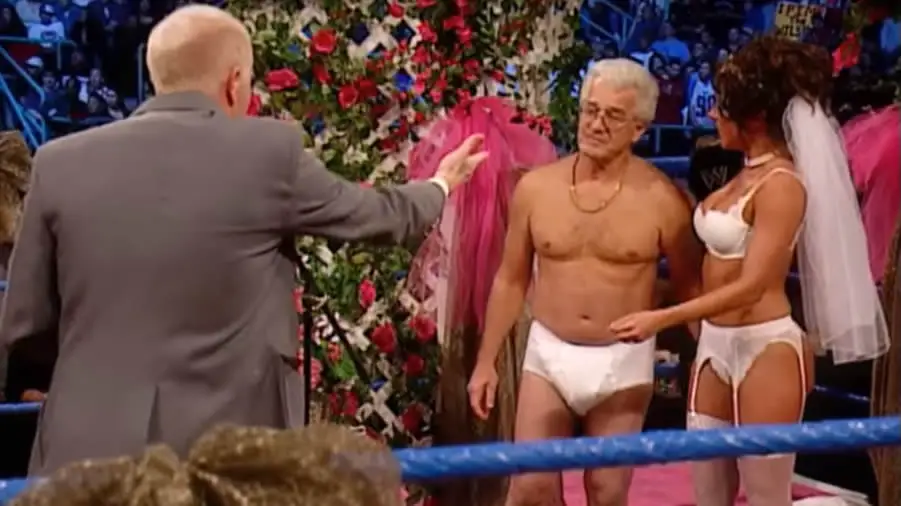 WWE
WWE
I say the Torrie vs. Dawn feud was ridiculous with a half-smile, because you can't help but be charmed by Torrie's father, Al. Al Wilson had all of the emotional depth and acting range of an extension cord, and that's why he was fantastic. It was a sad day when the storyline called for him to die from a post-coitus heart attack brought on by new wife, Dawn Marie.
Torrie fought for her dead dad's honour at the Rumble, defeating her, um, grieving stepmother in under four minutes (which was still probably five minutes too long). According to Dawn Marie, the angle wasn't originally supposed to be blown off here - it was to continue onward, with the involvement of Torrie's brother, as well as family lawyers, though it wasn't to be. And really, the card-carrying WrestleCrap contributor in me says, "Damn it all."
 WWE
WWE
Needless to say, the World Heavyweight title bout pitting Triple H against Scott Steiner missed its mark completely. Fans in Boston tired of the staggers and botches, as well as the repetitiveness, long before the merciful finish. The match degenerated into a Brock Lesnar Suplex fest at about quarter-speed, and the DQ finish was like using a vomit chunk for punctuation.
But both men had excuses - they were working at far less than 100 per cent. Steiner was working through drop foot syndrome, which left one of his feet in a paralytic state, and would not improve until a 2005 surgical procedure. Triple H, meanwhile, had a partially-torn right quadriceps and was nearly as immobile as his opponent. And yet, they still pushed on for 18 minutes - 18 mind-numbing minutes.
 WWE
WWE
It's a shame that the match was so bad, because in TNA just a few years later, Steiner looked worlds better inside the ring, despite reaching his mid-forties by that point. WWE carried on with the rematch at No Way Out that the feud had called for, but that was it for Steiner's push - WWE had given up on him.
Lance Storm would reveal how quickly WWE's faith in Steiner had bottomed out as soon as the paint dried on Steiner and Helmsley's Rumble match. The wrestler-turned-trainer would work house show matches with "Big Poppa Pump" soon after, and was told by agent Jack Lanza: "Get whatever the hell you can out of him," even if it meant keeping the match short to disguise Steiner's hindrances. Incredibly, Steiner would wrestle another year with the company, and wouldn't be officially released until the summer of 2004.
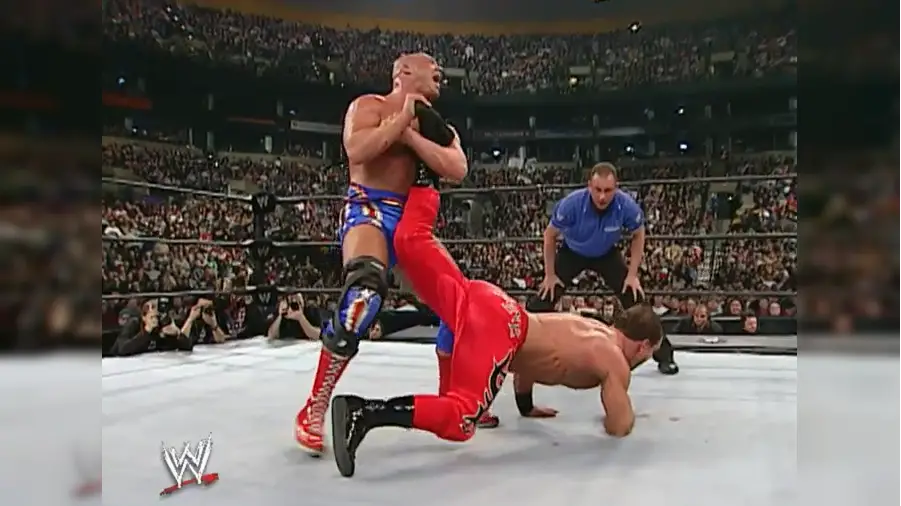 WWE
WWE
That Angle/Benoit WWE title match may as well have been eye-bleach for those that had to sit through Helmsley and Steiner - it was the complete opposite of the prior match in just about every way, hovering around perfection. To many, it was WWE's best match of 2003, depending on how you felt about Jericho/Michaels from WrestleMania 19, and Angle and Lesnar's Iron Man match.
In something of a tribute to the effectiveness of the match, consider that it took place all the way back in January, and yet would still fare well in year-end polls for the best in wrestling. For The Wrestling Observer Newsletter's annual awards, Angle/Benoit finished second in Match of the Year voting, narrowly losing out to a Mitsuharu Misawa/Kenta Kobashi match from Pro Wrestling NOAH. That fans still regarded Angle/Benoit that highly 12 months later speaks volumes.
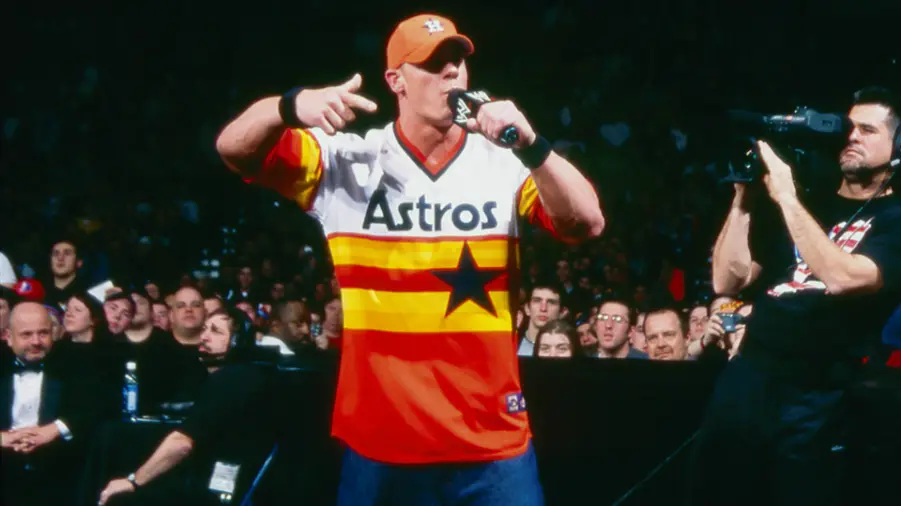 WWE
WWE
The WWE roster in January 2003 looked much different than it had one year earlier, for several reasons - Ohio Valley standouts were now graduating to the main roster, Attitude Era stars were being phased out after considerable tenures, and there was a matter of making WCW refugees fit in with WWE-approved snugness. As a result, there were a ton of Rumble first-timers in the 2003 match, 14 in all.
Out of those 14 first-timers, seven of them would be future top champions of WWE brands. Tommy Dreamer and Chavo Guerrero would each sit atop WWE's ECW brand, while the other five were all future World champs: Brock Lesnar, Batista, John Cena, Eddie Guerrero (yes, this was his first Rumble), and Rey Mysterio. And all but Guerrero would be eventual Rumble match winners, as well.
 WWE
WWE
The number one entrant into the match was also the first man gone: Shawn Michaels. After being jumped by rival and number two entrant, Chris Jericho, Michaels was split open before being casually dumped over the ropes after just two-and-a-half minutes. Michaels' light participation was due to his being unsure about assuming more active duties, and he had to be talked into working the Rumble, with his quick out being a compromise.
In this, the 16th overall Royal Rumble, it marked only the first time that number one was the first to go. Every Rumble between 1988 and 2002 (save for 1995) would see the second or third entrant get tossed out first. Since then, only a pair of number ones been the first one out - Ric Flair in 2007, and The Miz in 2015.
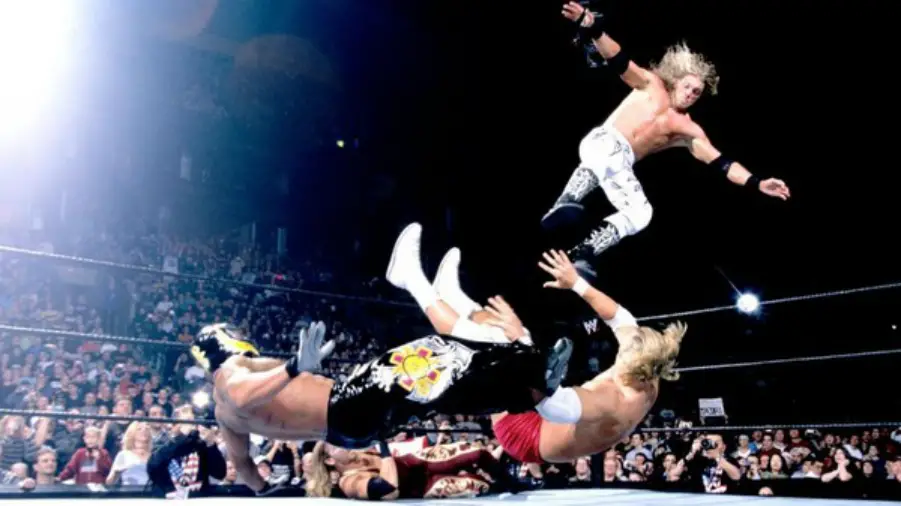 WWE
WWE
It was a rather unfortunate moment when promising young villain Christopher Nowinski had his skull sandwiched into the canvas by Edge, the result of a badly-timed double-team spot. Nowinski was clearly rattled by the move, and it would in fact spell a premature end to his career. Nowinski, after a period of trying to work through the after-effects, was forced into early-retirement in June 2003, due to post-concussion syndrome.
Since then, Nowinski's name has been synonymous with concussions in the world of sport. The Harvard graduate raises awareness about concussions through his founding of the Sports Legacy Institute (today the Concussion Legacy Foundation) and was the one who reached out to Chris Benoit's father Michael in the aftermath of Benoit's death to have his brain examined for CTE.
 WWE
WWE
Back to back entries in the Rumble match would see Rikishi hit the ring at number 20, followed by Three Minute Warning member Jamal at 21. As many have learned since, Jamal (the eventual Umaga) is Rikishi's kid brother, and here the familial Fatus were, about to exchange blows with a World title match at stake.
Thing is, in storyline, Rikishi and Jamal were never acknowledged as brothers - except for this one time, and possibly as a slip of the tongue. Jim Ross, in his call of the action, noted that Jamal had "gone after his brother, Rikishi", the only known time in kayfabe that Rikishi and Jamal were ever acknowledged as being related. Since nothing ever came of the brief skirmish afterwards, it was possibly just Good Ol' JR accidentally mixing reality with the story.
 WWE
WWE
Unless WWE felt like executing a swerve, the match was Brock Lesnar's to win, as revenge on WWE Champion Kurt Angle was destined to await him come WrestleMania 19 in Seattle. Lesnar hit the ring at the number 29 spot, steamrolled over much of the field, and would dump out The Undertaker in the finish in order to win.
It took until the 16th Royal Rumble for somebody to enter beyond number 27 and win the match. Never before in 15 prior Rumbles had 28, 29, or 30 ever won the match, despite the great potential that each draw possesses, and Lesnar's win would finally act as a breakthrough in that regard. Since then, 28 and 30 would each produce winners, which is consistent with the match's logic.
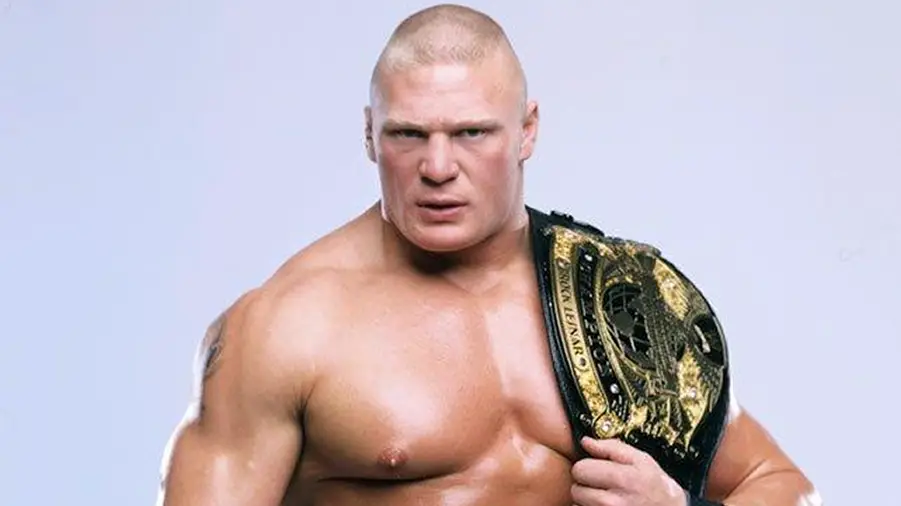 WWE
WWE
Lesnar's win capped off an incredible 10-month stretch, in which he debuted, won the King of the Ring, became WWE Champion, and won a Royal Rumble match. His first full year on the main roster would add in a WrestleMania main event, in what has to be the greatest "rookie year" in WWE history.
With the victory, Lesnar became (and remains) the youngest Rumble match winner ever at 25 years, six months of age. The previous holder of the honour was Yokozuna, who was 26 years, three months old when he won the match in 1993. Since then, the Rumble match has only produced two other winners in their twenties (28-year-old Randy Orton in 2009, 29-year-old Roman Reigns in 2015). Only two other men won the match in their twenties: Shawn Michaels (29 in 1995) and The Rock (27 in 2000).
The 2003 Royal Rumble is a microcosm of WWE that year, summing up the strengths and weaknesses of the product in a convenient three-hour block. There's tremendous wrestling (Angle vs. Chris Benoit), clunky wrestling from barely-mobile heavyweights (Triple H vs. Scott Steiner), ridiculous soap opera (Dawn Marie vs. Torrie Wilson), and a Rumble match with a great first half (buoyed by some of the top workers in the company) before giving way to a duller second half (populated by more sluggish heavyweights).
It's probably the third best pay-per-view of the year, behind excellence in WrestleMania 19 and Vengeance, but the 2003 Royal Rumble is still mightily flawed. That alone tells you all you need to know about the rest of the offerings from that calendar year.
10. Al Wilson Would've Wanted That
 WWE
WWEI say the Torrie vs. Dawn feud was ridiculous with a half-smile, because you can't help but be charmed by Torrie's father, Al. Al Wilson had all of the emotional depth and acting range of an extension cord, and that's why he was fantastic. It was a sad day when the storyline called for him to die from a post-coitus heart attack brought on by new wife, Dawn Marie.
Torrie fought for her dead dad's honour at the Rumble, defeating her, um, grieving stepmother in under four minutes (which was still probably five minutes too long). According to Dawn Marie, the angle wasn't originally supposed to be blown off here - it was to continue onward, with the involvement of Torrie's brother, as well as family lawyers, though it wasn't to be. And really, the card-carrying WrestleCrap contributor in me says, "Damn it all."
9. The Stumbles Don't Lie
 WWE
WWENeedless to say, the World Heavyweight title bout pitting Triple H against Scott Steiner missed its mark completely. Fans in Boston tired of the staggers and botches, as well as the repetitiveness, long before the merciful finish. The match degenerated into a Brock Lesnar Suplex fest at about quarter-speed, and the DQ finish was like using a vomit chunk for punctuation.
But both men had excuses - they were working at far less than 100 per cent. Steiner was working through drop foot syndrome, which left one of his feet in a paralytic state, and would not improve until a 2005 surgical procedure. Triple H, meanwhile, had a partially-torn right quadriceps and was nearly as immobile as his opponent. And yet, they still pushed on for 18 minutes - 18 mind-numbing minutes.
8. Push Killer
 WWE
WWEIt's a shame that the match was so bad, because in TNA just a few years later, Steiner looked worlds better inside the ring, despite reaching his mid-forties by that point. WWE carried on with the rematch at No Way Out that the feud had called for, but that was it for Steiner's push - WWE had given up on him.
Lance Storm would reveal how quickly WWE's faith in Steiner had bottomed out as soon as the paint dried on Steiner and Helmsley's Rumble match. The wrestler-turned-trainer would work house show matches with "Big Poppa Pump" soon after, and was told by agent Jack Lanza: "Get whatever the hell you can out of him," even if it meant keeping the match short to disguise Steiner's hindrances. Incredibly, Steiner would wrestle another year with the company, and wouldn't be officially released until the summer of 2004.
7. For Your Consideration
 WWE
WWEThat Angle/Benoit WWE title match may as well have been eye-bleach for those that had to sit through Helmsley and Steiner - it was the complete opposite of the prior match in just about every way, hovering around perfection. To many, it was WWE's best match of 2003, depending on how you felt about Jericho/Michaels from WrestleMania 19, and Angle and Lesnar's Iron Man match.
In something of a tribute to the effectiveness of the match, consider that it took place all the way back in January, and yet would still fare well in year-end polls for the best in wrestling. For The Wrestling Observer Newsletter's annual awards, Angle/Benoit finished second in Match of the Year voting, narrowly losing out to a Mitsuharu Misawa/Kenta Kobashi match from Pro Wrestling NOAH. That fans still regarded Angle/Benoit that highly 12 months later speaks volumes.
6. Future Greatness
 WWE
WWEThe WWE roster in January 2003 looked much different than it had one year earlier, for several reasons - Ohio Valley standouts were now graduating to the main roster, Attitude Era stars were being phased out after considerable tenures, and there was a matter of making WCW refugees fit in with WWE-approved snugness. As a result, there were a ton of Rumble first-timers in the 2003 match, 14 in all.
Out of those 14 first-timers, seven of them would be future top champions of WWE brands. Tommy Dreamer and Chavo Guerrero would each sit atop WWE's ECW brand, while the other five were all future World champs: Brock Lesnar, Batista, John Cena, Eddie Guerrero (yes, this was his first Rumble), and Rey Mysterio. And all but Guerrero would be eventual Rumble match winners, as well.
5. Can't Stay Long
 WWE
WWEThe number one entrant into the match was also the first man gone: Shawn Michaels. After being jumped by rival and number two entrant, Chris Jericho, Michaels was split open before being casually dumped over the ropes after just two-and-a-half minutes. Michaels' light participation was due to his being unsure about assuming more active duties, and he had to be talked into working the Rumble, with his quick out being a compromise.
In this, the 16th overall Royal Rumble, it marked only the first time that number one was the first to go. Every Rumble between 1988 and 2002 (save for 1995) would see the second or third entrant get tossed out first. Since then, only a pair of number ones been the first one out - Ric Flair in 2007, and The Miz in 2015.
4. Turning Lemons To Lemonade
 WWE
WWEIt was a rather unfortunate moment when promising young villain Christopher Nowinski had his skull sandwiched into the canvas by Edge, the result of a badly-timed double-team spot. Nowinski was clearly rattled by the move, and it would in fact spell a premature end to his career. Nowinski, after a period of trying to work through the after-effects, was forced into early-retirement in June 2003, due to post-concussion syndrome.
Since then, Nowinski's name has been synonymous with concussions in the world of sport. The Harvard graduate raises awareness about concussions through his founding of the Sports Legacy Institute (today the Concussion Legacy Foundation) and was the one who reached out to Chris Benoit's father Michael in the aftermath of Benoit's death to have his brain examined for CTE.
3. Sibling Rivalry
 WWE
WWEBack to back entries in the Rumble match would see Rikishi hit the ring at number 20, followed by Three Minute Warning member Jamal at 21. As many have learned since, Jamal (the eventual Umaga) is Rikishi's kid brother, and here the familial Fatus were, about to exchange blows with a World title match at stake.
Thing is, in storyline, Rikishi and Jamal were never acknowledged as brothers - except for this one time, and possibly as a slip of the tongue. Jim Ross, in his call of the action, noted that Jamal had "gone after his brother, Rikishi", the only known time in kayfabe that Rikishi and Jamal were ever acknowledged as being related. Since nothing ever came of the brief skirmish afterwards, it was possibly just Good Ol' JR accidentally mixing reality with the story.
2. Late Arrival
 WWE
WWEUnless WWE felt like executing a swerve, the match was Brock Lesnar's to win, as revenge on WWE Champion Kurt Angle was destined to await him come WrestleMania 19 in Seattle. Lesnar hit the ring at the number 29 spot, steamrolled over much of the field, and would dump out The Undertaker in the finish in order to win.
It took until the 16th Royal Rumble for somebody to enter beyond number 27 and win the match. Never before in 15 prior Rumbles had 28, 29, or 30 ever won the match, despite the great potential that each draw possesses, and Lesnar's win would finally act as a breakthrough in that regard. Since then, 28 and 30 would each produce winners, which is consistent with the match's logic.
1. The Power Of Youth
 WWE
WWELesnar's win capped off an incredible 10-month stretch, in which he debuted, won the King of the Ring, became WWE Champion, and won a Royal Rumble match. His first full year on the main roster would add in a WrestleMania main event, in what has to be the greatest "rookie year" in WWE history.
With the victory, Lesnar became (and remains) the youngest Rumble match winner ever at 25 years, six months of age. The previous holder of the honour was Yokozuna, who was 26 years, three months old when he won the match in 1993. Since then, the Rumble match has only produced two other winners in their twenties (28-year-old Randy Orton in 2009, 29-year-old Roman Reigns in 2015). Only two other men won the match in their twenties: Shawn Michaels (29 in 1995) and The Rock (27 in 2000).
